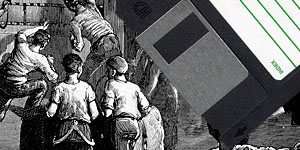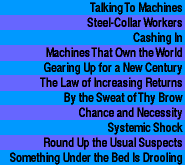


Cashing In
In 1977, Citibank's share of retail deposits was less than 5 percent. The bank's officers saw that it could make more money by reducing unit costs and attracting more low-balance customers. So they invested over 250 million dollars in roughly five hundred cash machines. By 1982, Citibank's market share had more than doubled, and it continued to rise thereafter by about 1 percent a year. By 1990, its share of the noncommercial market had tripled.Between 1983 and 1993, American banks shed almost 180 thousand tellers---over a third of their work force. Today, many new bank branches are merely a series of cash machines set into a wall, with no tellers at all. Cash-machine transactions cost banks half as much as teller transactions, and America's eighty-five thousand cash dispensers work around the clock, servicing over eight thousand million transactions a year. Today, a bank's cash machine network isn't a competitive advantage; it's an economic necessity.
Nor does the story of commercial change end with the computer's effect on entry-level jobs. Like talented employees, computers start at or near the entry-level positions and work their way up when, after extended contact, senior people see how useful they are. They can do anything we know how to tell them to do. So when we buy them for one purpose and work with them for a while, we soon see a whole world of other uses for them. First we thought computers could partially replace clerks and switchboard operators, then secretaries, bank tellers, and service workers. Now computers are changing the jobs of entry-level managers, middle managers, and professionals like stockbrokers, lawyers, and accountants. One day they may threaten executives, programmers, psychiatrists, generals, politicians, doctors, and professors.
Often the computer's introduction leads to job loss, loss of job skills, and feelings of dehumanization. When a business uses computers, its employees become more interchangeable, more reliable, more controllable, and---usually---cheaper. The siren call of automation results in step-by-step changes in jobs to make them fit better into the maw of the beast. Just as the industrial revolution turned artisans into factory hands, the information revolution is turning white-collar workers into machine tenders.
Today, only 3 percent of Americans are still on the farm; yet they produce enough food to feed the other 97 percent of the population, plus enormous quantities for export. The same thing may eventually happen to American manufacturing, which now employs about 20 percent of the labor force. The tendency toward automation is widespread and inevitable: on the farm, in the factory, the home, the hospital, the office, and just about everywhere else.
At certain financial management and brokerage firms, for example, new brokers must now use a companywide computer program. It gives brokers standard, company-approved ways to build stock portfolios and investments while preventing them from making potentially unwise choices. The company thus achieves a more uniform policy that is more predictable, and more profitable. Most banks, credit card companies, and other financial institutions now approve credit or loans using similar programs. These analyze the characteristics of thousands of past customers, looking for ways to distinguish between those who pay up and those who default. The programs often boil down to a long list of rules like "If the requester is young, single, a renter, unemployed, and has already defaulted on other loans, don't approve the request. If the requester is middle-aged, married, a homeowner, makes a lot of money, and has never defaulted on any loan, approve the request." Basically, the rule is: lend only to those who need not borrow.
Such programs cut training time for new clerks, who can now be hired fresh out of university and immediately put to work. It also gives both the customer and the company a safety net, since the system can compensate for clerk inexperience, tiredness, or sloppiness. Finally, it makes firing clerks much easier, because replacements can be quickly taught how to use the company's programs.
That's the same system that fast-food chains use to shape a low-wage work force to produce a uniform product worldwide. A new employee can be trained to operate the machines in half an hour and is paid commensurately. If the employee chooses not to come to work one day, the manager can take anyone off the street to do the same job at the same pay. At other corporations, the same thing is happening to middle managers, and the computer is creeping slowly and inexorably up the chain of command. Highly paid financial brokers and other professionals are turning into the equivalent of short-order cooks. Corporations are using computers to eat the middle class.
Of course, that isn't news. Whenever a machine moves into a new field the same thing happens: The product becomes cheaper and more available but less well made. Skilled workers are displaced, and less skilled workers (or none at all) take their place. It happened with printing presses; it happened with mechanical looms; it happened with sewing machines. Now it's happening with computers.
Displaced employees can only complain that the product---whether ploughed fields, books, dresses, paper, cars, stock options, telephones, or nuclear weapons---isn't as well made as when they made it. However true, that fact is usually far outweighed by the product's wider availability, lower cost, greater uniformity, and its improved adaptability to design change. Further, after the initial phase, competition among the providers usually improves it so much that it becomes even better than all but the best of the original handmade items. It's hard to fight such an enormous incentive to change.